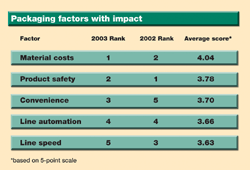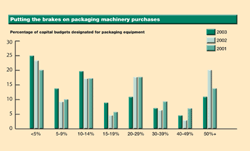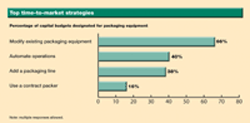
They aren’t, however, and it’s hard to put a happy face on packaging’s diminishing share of a modest capital pie.
That’s one of the findings of Food Engineering’s packaging trends study, based on an annual survey of readers with packaging responsibilities.
Food Engineering readers reported that spending on both equipment and materials will be modest at best. Three in five respondents, up sharply from 2002, expect to spend less than $100,000 on packaging equipment this year. Material spending also is lean, with 51 percent budgeting less than $500,000, up from 31 percent last year and 40 percent in 2001. However, the sample skewed slightly toward smaller plants than 2002’s respondent pool.
The news isn’t all bad. More than a third of companies expect to spend more on packaging equipment this year than last, triple the number who are poised to slash spending. Most anticipate greater expenditures for packaging materials, as well. On the other hand, the dollars being cut by firms that are retrenching exceeds the budgetary growth of those who are expanding.

One in four plants (24.6 percent) are committing less than 5 percent of their capital budgets to packaging machinery, the largest proportion to report such modest spending plans in recent years. In almost every instance, large-proportion spending is down while modest-portion budgets are up (see chart above).
Given the grim market in 2002, those spending plans might send shudders through the packaging machinery community. In its report on fourth quarter 2002 equipment purchase activity, the Packaging Machinery Manufacturers Institute (PMMI) projected a modest 1 percent growth in new machinery orders. However, growth was relative to a third quarter that saw precipitous declines. The majority (57 percent) of surveyed machine makers reported lower sales in the third quarter. Business uncertainty and excessive manufacturing capacity caused a 4.1 percent decline in machinery sales in 2002.
The economic stagnation that has lingered since 2001 continues to be a drag on food manufacturers’ packaging upgrade plans. Almost two in five respondents—38.5 percent—said equipment and material upgrade projects have been cut back this year, and 6.2 percent said capital projects have been eliminated. Comparable numbers last year were 35 percent and 9 percent. In 2001, the proportions were a dismal 49 percent and 7 percent. Half said the economy was a factor, the same proportion as last year and considerably lower than 2001, when almost two thirds curbed spending because of the economy.

Tapping new technology
Market demands will be served with many of the material changes planned by food companies. Although the 36 percent of respondents indicating change was likely is modest compared to last year’s 46 percent, it is consistent with earlier years.Many of the anticipated changes are cosmetic in nature: bolder graphics, more decorative shrink wrap, more dynamic shapes. But functionality also gets its due, with easy-open containers, tamper-evident seals and tougher polybags cited by some. Environmental concerns also are driving change. Two respondents indicated they are increasing the amount of recycled material in their packaging, and another plans to install dust-handling and personal-safety equipment to improve the environment inside the plant.
Both form and function are served by the reader who wrote, “Higher end, higher dollar packaging with preprinted graphics is being introduced, with clear shrink tube for tamper evidence to meet the expectations of higher income consumers.” Another attributes the introduction of a flexible packaging line to market demands.
Functionality was the biggest driver in new package development, readers indicate. “Product protection and preservation” was rated as very important by 72 percent of respondents, higher than cost, printing & graphics quality, brand image and even consumer convenience. Belying the environmental considerations cited above, only 17 percent rated source reduction as very important. While printing & graphics received middle-of-the-road scores in importance, the 59 percent who rated those factors as very important was 10 points higher than in 2001’s survey.
Packaging line changes were slightly more common than material changes last year, though the two often went hand in hand. “All new line for new type of pack” and “modified three packaging lines for new style package” were typical comments from the 39 percent of respondents reporting equipment changes. Customer requirements and obsolescence also drove change. “Change was driven by poor reliability of case packer and case coders that were old and parts were no longer available,” one reader wrote.
Packaging engineers are investing considerable time and effort to standardize software and operating principles of packaging machinery and make integration easier to accomplish. The OMAC Working Group on Packaging Standardization is the most visible example of this effort. Those projects are eliciting a collective yawn, however. Standardized controls and software ranked 15 out of 18 factors in importance when purchasing machinery. Servo drives, a standardization candidate near and dear to OMAC’s heart, ranked even lower at 17, trailed only by modularity, perennially the lowest priority.
Safety ranked as the highest purchasing priority, though its average score of 4.13 on a 5-point scale was virtually the same as last year. Accuracy, cost and ease of use followed. Machine speed wasn’t a major issue with this year’s respondents: speed ranked eighth on the purchase-importance list, down from fourth.
Written comments by survey respondents reflect an appreciation of the cost in relation to value when purchasing equipment. “Cost is discovered in safety, training, ease of use, ease of integration and maintenance,” one wrote. “Cost is important for the value, not simply the lowest price.”

Supply chain management specialists are buzzing about the prospects for RFID technology, the miniature semiconductors and antennae that can be imbedded in shipping labels to facilitate receiving and inventory procedures. Radio frequency identification has implications that extend beyond logistics and include security (see Technology Update on page 109). But RFID barely makes the charts with food professionals: only 3 percent of respondents think it will have a big impact on their operations in the next two years, rivaling management software on the survey’s indifference scale.
Technology that is used on the plant floor is of greater interest, and a number of readers are implementing leading-edge technologies. Two survey respondents said their plants have installed X-ray inspection systems in the packaging department, and another converted to laser product coding, along with in-line scale labeling. Plastic UV-resistant beer bottles and resealable aluminum bottles were among the technologies being investigated but not implemented.
Finally, readers were polled about which of eight packaging changes their companies had made in the last year (multiple responses were allowed). Not surprisingly, 39 percent are using more plastic packaging, including 31 percent employing more pouches. But paperboard scored highly, as well, with 28 percent indicating increased use of this material. Vacuum packaging technology also is on a growth path, with 24 percent indicating greater use.
Vacuum packing offers superior protection to modified atmosphere packaging (MAP), though the decision of which to use often comes down to customer preference. Based on survey results, customers may be waking up to the functional advantages of vacuum packs: four times as many food companies increased their use of vacuum packaging than those who upped their usage of MAP technology. MAP growth was only slightly ahead of metal, which is being used more by one in 25 readers.
